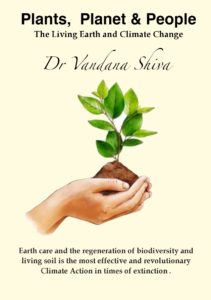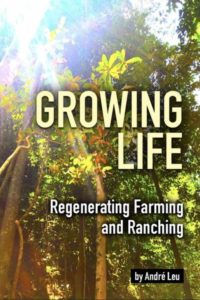On October 29, 2021, Navdanya International hosted an online event “Regeneration for Climate Resilience – Will the COP26 still rely on False Solutions?”, with Dr. Vandana Shiva, President of Navdanya International, André Leu – International Director of Regeneration International, and former President of IFOAM – Organics International; and Tom Newmark – co-founder and chair of The Carbon Underground. In preview to the upcoming COP26, this discussion focused on how true biodiversity-based, ecological and cultural regeneration is needed to build climate resilience for the future.
Ruchi Shroff, Director of Navdanya International, introduced the discussion by explaining how the relentless exploitation of the Earth’s resources has led us down the path of possible, irreversible climate change, along with biodiversity erosion and extinction of species.
In the name of solving the climate crisis, large corporations, industries, and lobby groups are now promoting a whole range of ineffective, costly, unproven, and sometimes dangerous techno-fix solutions that completely deny the power of nature to regenerate, by attempting to technologically replace the natural processes they have been destroying. Allowing corporations to be able to continue to pollute, while also creating new carbon markets. But we have instead the choice to go down a different path, that acknowledges the central role food systems have in building climate resilience and regenerating the planet, and that works hand in hand with nature and her natural processes of cycling carbon which provide the basis of all life.
Tom Newmark stressed how already 15 years ago climate scientists were saying that it would have been impossible to meet the carbon budget under the Kyoto Protocol without a dramatic re-imagination of land use worldwide. In 2009, US former vice president Al Gore articulated the theories of regenerative agriculture and soil restoration as a climate mitigation strategy in his book “Our Choice: A Plan to Solve the Climate Crisis”. Moreover, in 2013, a really important collection of papers – called “Wake Up Before It’s Too Late” was published by the United Nations Commission on Trade and Development, as a warning and a call to action on the opportunity of regenerative agriculture.
However, the most recent IPCC report gave no attention to the opportunity of regenerative agriculture and reimagining our relationship with Mother Earth. So the question is, why this failure? Tom’s theory is that, even in the scientific community, there still is a huge lack of understanding of the relationship of our planet and our soils to the regulation of the equilibrium needed on Mother Earth to support life. As he explained in his article “Don’t Call Mother Nature a Sink!”, perhaps the term sink itself is problematic. Soil is not a sink. Or a bathtub. Carbon flowing through the soil-food web doesn’t go “into” a tank. What soil is, instead, is living tissue that grows or contracts depending on how it is nourished or exercised. If we stopped thinking of our planet as simply being this inert physical sink that fills up and then has no further capacity, but instead reimagine, and create a new relationship to Mother Earth as still an athlete in her prime, and if we gave Mother Earth and give our soils the care and the treatment they deserve, that is how we can integrate into the living tissue of Mother Earth billions of tonnes of carbon every single year.
Andre Leu presented a number of data sets showing how the last time the world had 380 ppm, based on evidence from 3.0–3.5 Million years ago, temperatures were from 5 to 16 C warmer (28.8 F) [Rohling et al., Nature], and sea levels were 20 to 30 meters higher (65 to 100 ft). When we look at this year’s atmospheric carbon dioxide measurement at NOAA’s Mauna Loa Atmospheric Baseline Observatory, in May 2021, the monthly average peaked for the year at 419 parts per million (ppm), which is the highest level since accurate measurements began 63 years ago. It becomes evident how the situation is getting worse despite the Paris agreement at COP21 in 2015. CO2 levels are now increasing by 2 to 3.3 ppm per year, which means that we will reach a number close to 500 ppm, according to the Paris target of Net Zero Emissions by 2050. We are looking at crossing the multiple tipping points of catastrophic climate change.
In light of this, the fact is that “Net Zero” is not enough– we have to go negative. To be able to go negative we need to start drawing down carbon into the soil. Soils, after the oceans, can hold huge amounts of carbon. Over 2700 Gt of carbon is stored in soils worldwide, which is 3 times the amount of carbon of all the forest and the atmosphere combined. Hence, it would be most logical to remove the CO2 from the atmosphere and put it into the soil – where it is needed. A challenge easily met through the practices of regenerative agriculture. In his new book “Growing Life – Regenerating Farming & Ranching”, Andre Leu explores the fundamentals of regenerative agriculture, including specific, proven steps designed to grow healthy food, while protecting our natural resources like clean water, soil and air.
We need to understand the basic principle of photosynthesis, which uses the energy of the sun, and takes carbon dioxide and water in the lives of plants to create “the molecules of life”. Around 95 to 98 percent of a plant’s biomass is composed of these molecules, made through sunlight, water and CO2, and plants synthesize sugars, amino acids and other carbon compounds from glucose. Around 30 percent of carbon compounds are secreted through the plant’s roots to feed the soil microbiome. This is called the liquid carbon pathway, or the “carbon gift.” In regenerative agriculture systems, we no longer have weeds. We have cover crops that we manage, in order to provide nutrients to the soil microbiome, so that our cash crops can grow on fertile soil. We can use this knowledge for managing how we farm, to stop using external chemical inputs and start instead to work with biology and living systems.
Dr Vandana Shiva underlined the importance of the distinction between living carbon, which is the building block of life, and dead carbon. The term “decarbonisation” is therefore shortsighted and dangerous and is leading to false solutions to the climate crisis. Just 200 years ago dead carbon started to be mined and became one the foundation of western civilisation, which also saw as inferior those cultures that instead had chosen to live according to the laws of nature. These populations were the ones who have now become the most affected by climate extremes, while people who did cause the problem continue to find ways to make profit from pollution.
The climate treaty 1992 was supposed to both be a reduction of emissions by those polluting as well as climate justice that those who have polluted are held accountable. But, then, in Copenhagen in 2009, the climate discussion was reduced to carbon trading, allowing polluters to continue to pollute through the creation of carbon markets and carbon offsets. The same interest groups that drove countries to accept a captivity to dead carbon through “development” criteria based on the use of fossil fuel and its derivatives, are now trying to push a variety of false solutions. A push that we will see take place at COP26 in Glasgow in the coming weeks.
In total denial of the power and potential of plants and living soil to recycle carbon and cool the planet, false solutions like geoengineering are being pushed. Geoengineering would artificially change the climate and can only be implemented on a massive scale, therefore any side effects or unintended consequences would also impact globally. Or the highly inefficient carbon capture technologies, which would cost more than $5 trillion per year to remove all of humanity’s annual carbon emissions. Fake food is also advertised as “eco-friendly” and is being proposed as a solution to the climate crisis, but yet it is made with proteins from pea, soy, or corn which are being grown with monocultures, toxic pesticides, and GMOs. Regarding the goal of ‘Net Zero’, through new conditionalities and a global certification system, polluters can lock communities into new “carbon trade” and “carbon farming”, through which polluters can ‘fix’ or offset their pollution by appropriating land and forests, leading to further displacement of indigenous peoples and small farmers. This is how ‘Net Zero’ became a clever way to continue this carbon trading, through what Nnimmo Bassey calls carbon slavery and indigenous peoples call carbon colonialism.
In light of this, it is important to not stop resisting and advocating for a transformative approach based on agroecology, which – as a practice of regenerative agriculture – represents a cornerstone of the necessary paradigm shift for building climate resilience by regenerating our planet, our biodiversity, our local communities, our health, and our democracy.
Also Read
Plants, Planet & People – The Living Earth and Climate Change
By Dr Vandana Shiva
Earth care and the regeneration of biodiversity and living soil is the most effective and revolutionary Climate Action in times of extinction.
 The solutions to Food Crisis, Biodiversity Erosion and the Climate emergency lie in making peace with the Earth, recognising that the Earth is living, her biodiversity and biosphere regulate her climate, and are the ecological foundation of food production. The more closely and intimately we work in partnership with nature according to ecological laws, the more we serve Mother Earth and care for her, the more we intensify photosynthetic activity and increase biodiversity and biomass, we conserve and regenerate biodiversity. Biodiversity regeneration and intensification allows us to grow diverse, healthy food and reverse hunger, malnutrition and disease. The more dense we make the ecological circular economies of nutrition in partnership with nature’s recycling, the more fertile our soils become, we reverse desertification. By recycling carbon and nitrogen while ending our dependence on fossil fuels, we reverse atmospheric pollution and address climate change. Working in partnership with nature to regenerate the biodiversity of her plants and biodiversity in the soil is the real solution to Climate Change. Read full report
The solutions to Food Crisis, Biodiversity Erosion and the Climate emergency lie in making peace with the Earth, recognising that the Earth is living, her biodiversity and biosphere regulate her climate, and are the ecological foundation of food production. The more closely and intimately we work in partnership with nature according to ecological laws, the more we serve Mother Earth and care for her, the more we intensify photosynthetic activity and increase biodiversity and biomass, we conserve and regenerate biodiversity. Biodiversity regeneration and intensification allows us to grow diverse, healthy food and reverse hunger, malnutrition and disease. The more dense we make the ecological circular economies of nutrition in partnership with nature’s recycling, the more fertile our soils become, we reverse desertification. By recycling carbon and nitrogen while ending our dependence on fossil fuels, we reverse atmospheric pollution and address climate change. Working in partnership with nature to regenerate the biodiversity of her plants and biodiversity in the soil is the real solution to Climate Change. Read full report
Growing Life – Regenerating Farming & Ranching
Andre Leu’s newest book
 As modern farming and ranching evolve away from mass consolidation and industrialization, a new strategy is rapidly emerging: regenerative agriculture. These new systems being implemented across the globe require a shift in the mindset of the land manager and operator, away from being primarily reliant on external inputs such as fertilizers and pesticides, and toward dependence on knowledge, measurement and management. In this first-of-its-kind book, André Leu invites everyone to start moving a positive, regenerative direction where our actions support growing abundant life. Inside this book, the first in a series, explore the fundamentals of regenerative agriculture, including specific, proven steps designed to grow healthy food, while protecting our natural resources like clean water, soil and air. Learn more – Watch Book Launch Video
As modern farming and ranching evolve away from mass consolidation and industrialization, a new strategy is rapidly emerging: regenerative agriculture. These new systems being implemented across the globe require a shift in the mindset of the land manager and operator, away from being primarily reliant on external inputs such as fertilizers and pesticides, and toward dependence on knowledge, measurement and management. In this first-of-its-kind book, André Leu invites everyone to start moving a positive, regenerative direction where our actions support growing abundant life. Inside this book, the first in a series, explore the fundamentals of regenerative agriculture, including specific, proven steps designed to grow healthy food, while protecting our natural resources like clean water, soil and air. Learn more – Watch Book Launch Video
Don’t Call Mother Nature a Sink!
By Tom Newmark
 « Soil is not a sink. Or a bathtub. Carbon flowing through the soil-food web doesn’t go “into” a tank, and we’ve got to stop talking like it does. What soil is, instead, is living tissue that grows or contracts depending on how it is nourished or exercised. After all, when carbon flows into the tissue of the soil, it doesn’t compact the soil as it would if the carbon was filling up the empty spaces in a tank. Carbon-rich soil is more porous, creating what is called the soil water battery, the spongelike tilth of healthy soil that actually increases in volume as soil organic matter increases. » Read more
« Soil is not a sink. Or a bathtub. Carbon flowing through the soil-food web doesn’t go “into” a tank, and we’ve got to stop talking like it does. What soil is, instead, is living tissue that grows or contracts depending on how it is nourished or exercised. After all, when carbon flows into the tissue of the soil, it doesn’t compact the soil as it would if the carbon was filling up the empty spaces in a tank. Carbon-rich soil is more porous, creating what is called the soil water battery, the spongelike tilth of healthy soil that actually increases in volume as soil organic matter increases. » Read more
Bill Gates & His Fake Solutions to Climate Change – Navdanya International, April 2021
UNFSS – Where Multinationals Continue to Design our Food Systems and Control our Diets – Navdanya International, July 2021
Earth Democracy: Connecting the Rights of Mother Earth to People’s Rights and the Well-being of All, Navdanya, Mother Earth Day, 2021
Seeds of Hope, Seeds of Resilience – How Biodiversity and Agroecology offer Solutions to Climate Change by Growing Living Carbon, Navdanya, 2017
